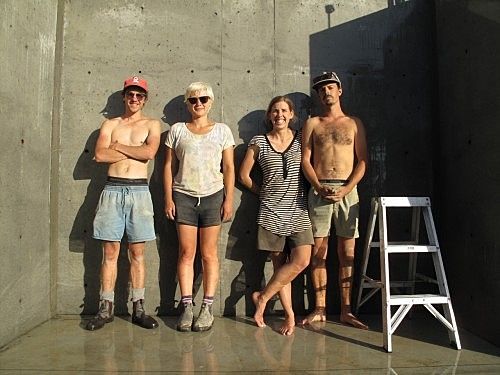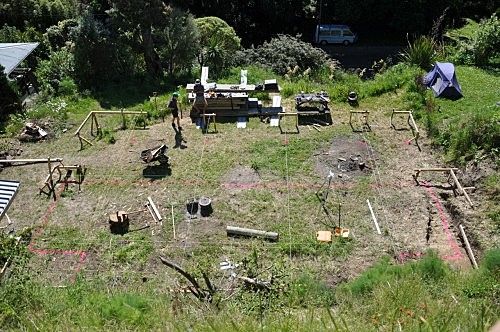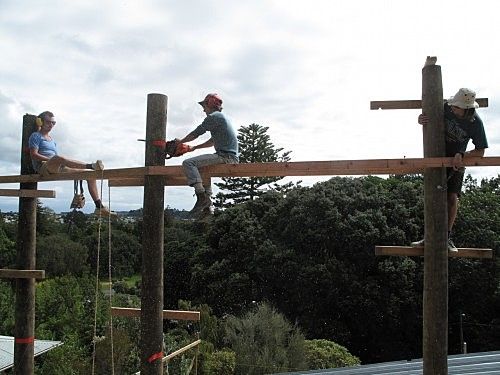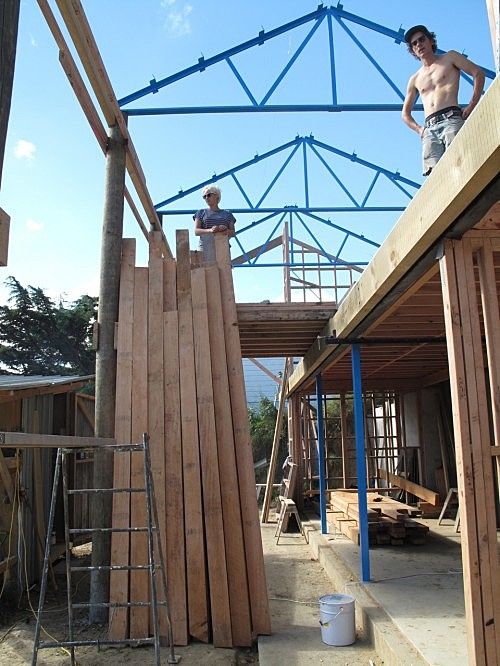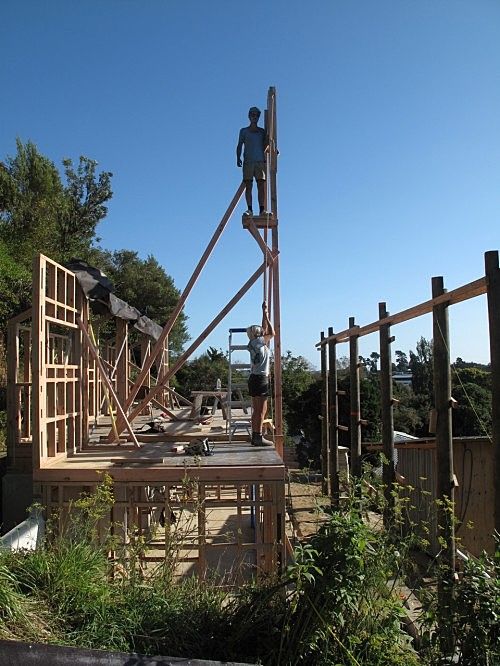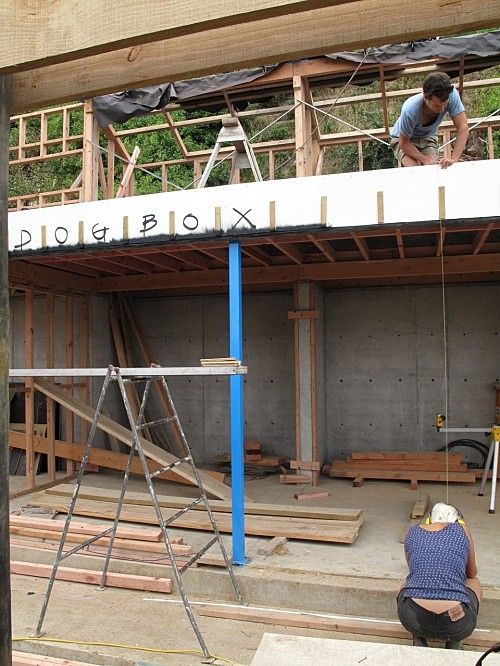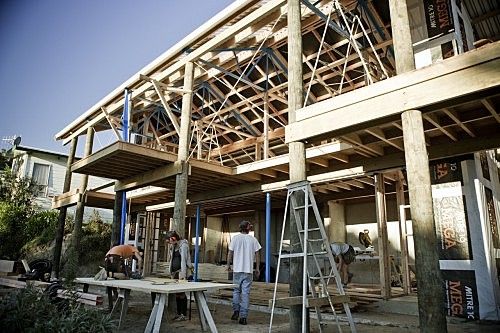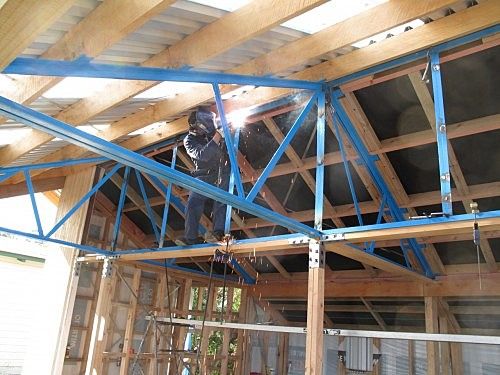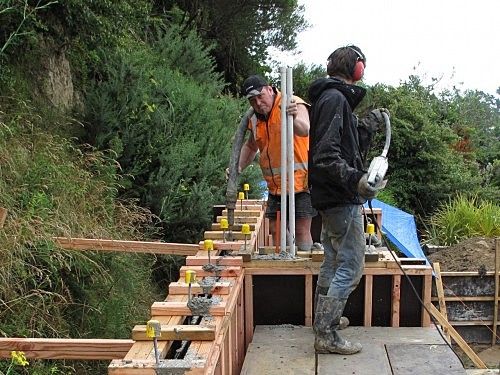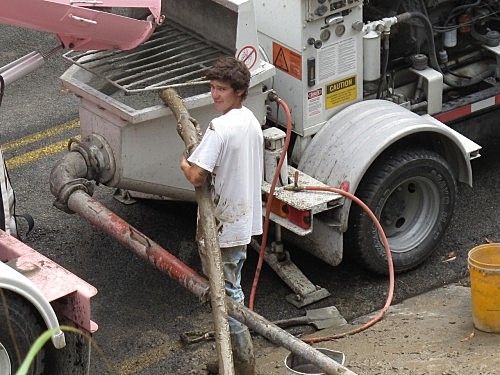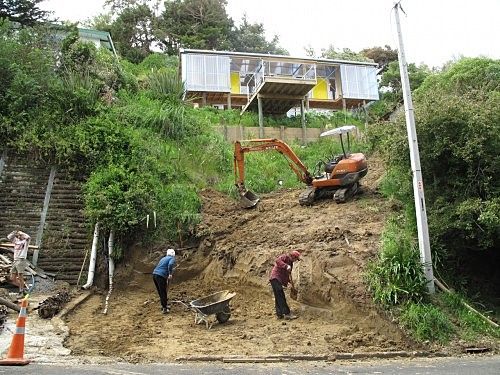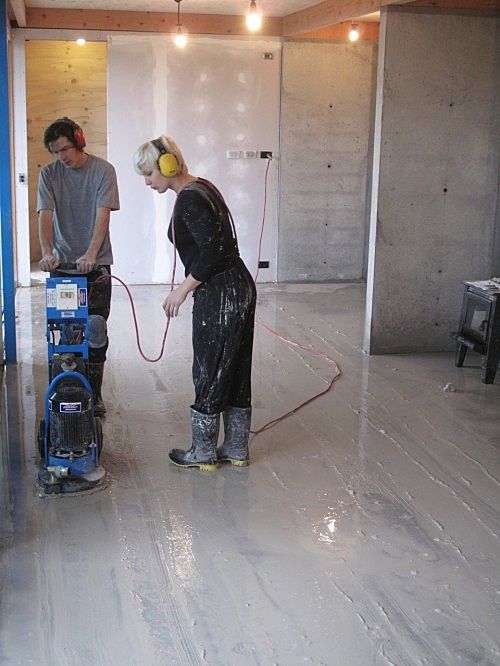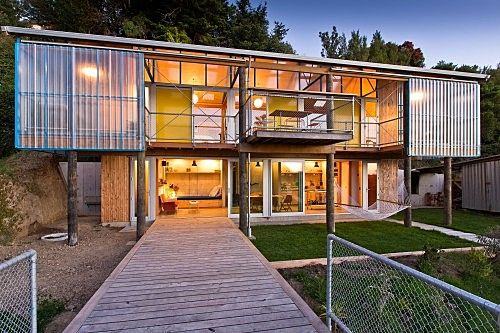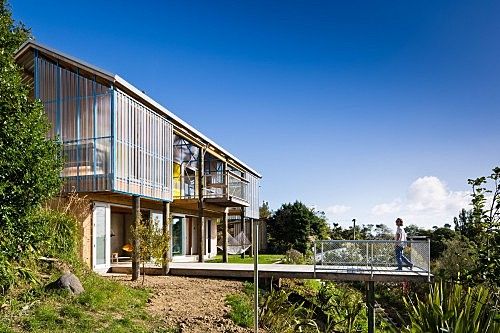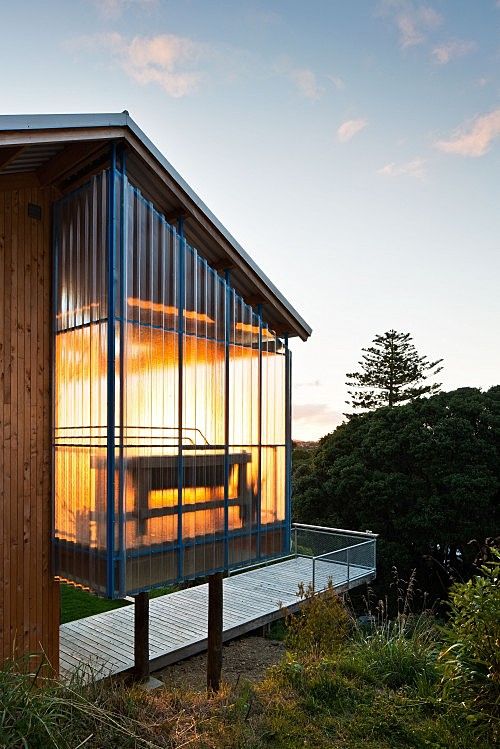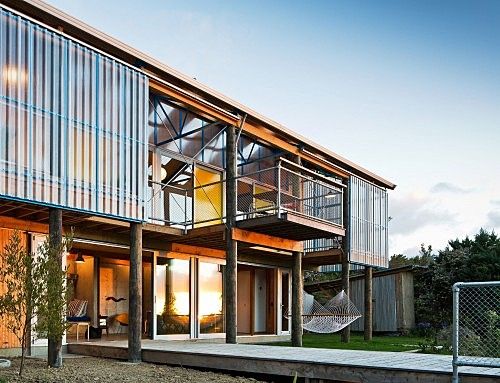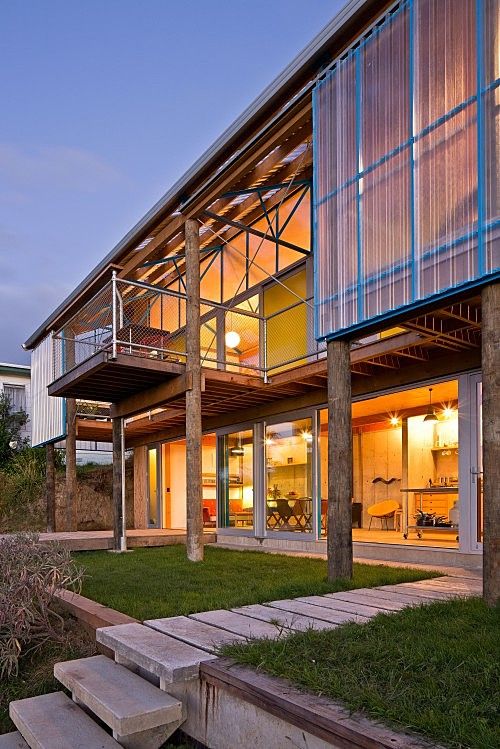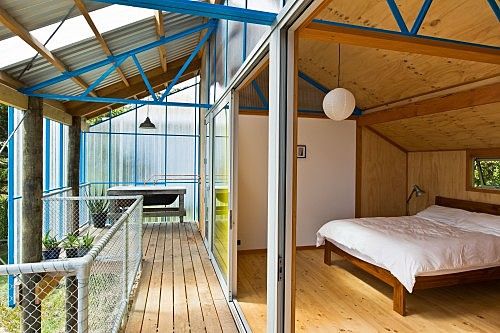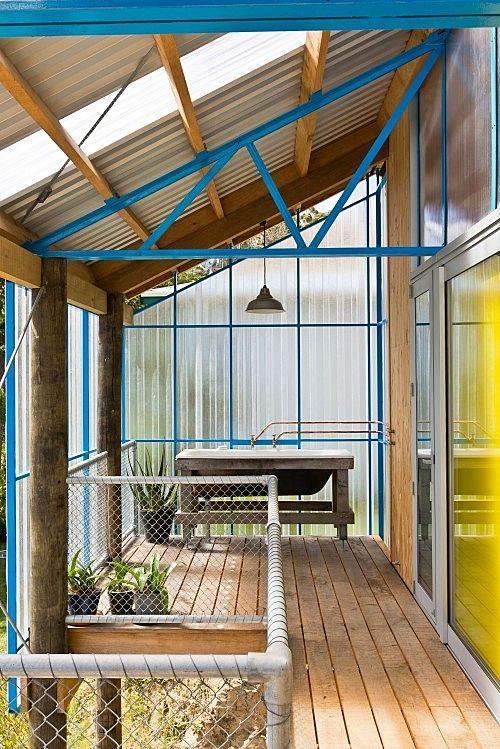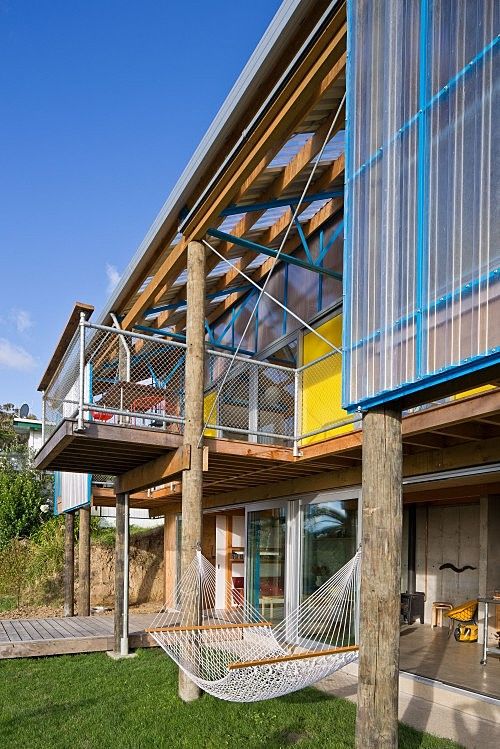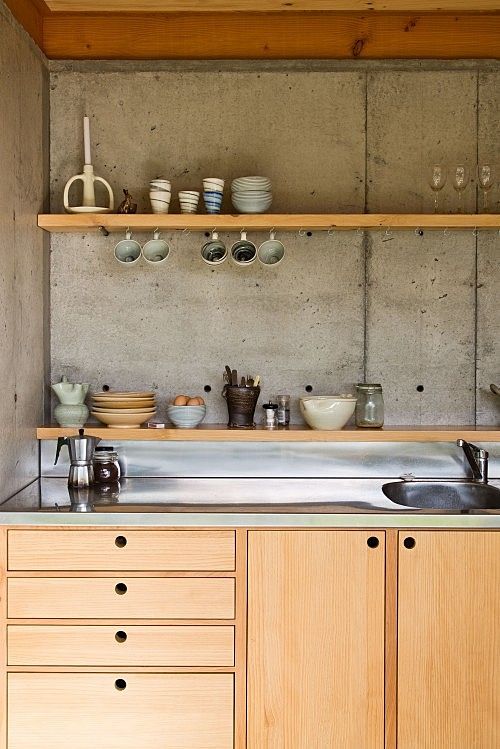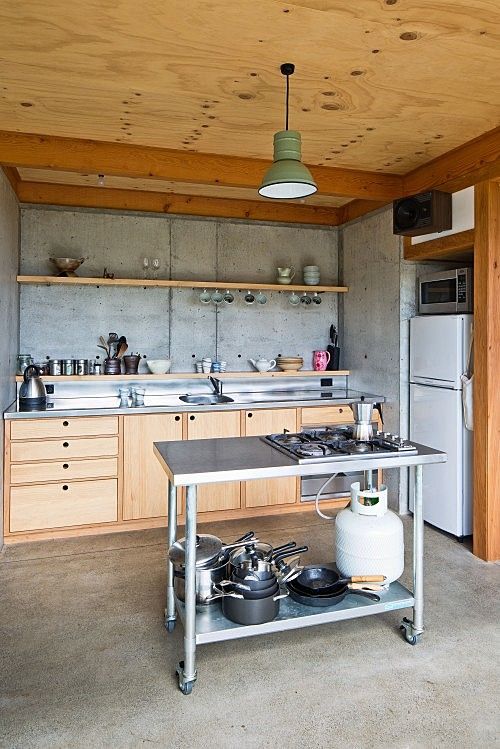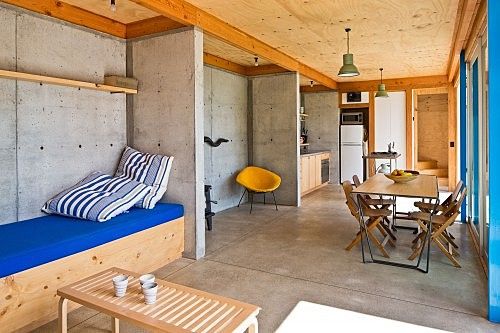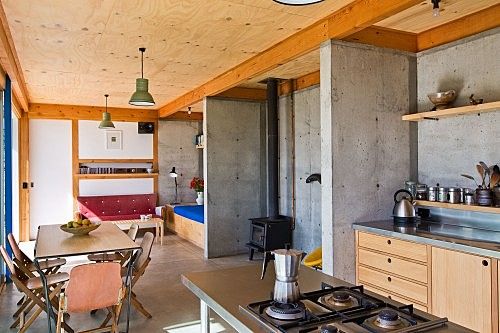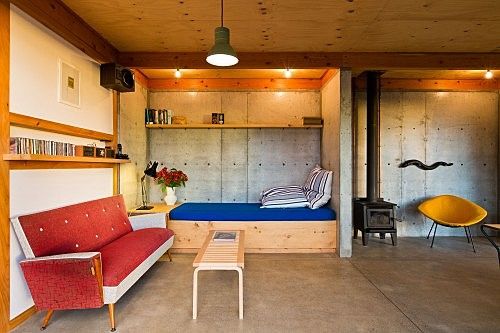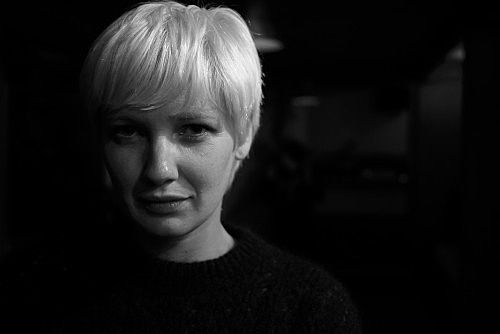A House of One's Own: Building The DOGBOX
A steep section, a tiny budget and four untrained builders. It could have been a spectacular failure. Thankfully, it wasn't. Sally Ogle talks about building her first house.
At first, we simply wanted some land. To have a bit of ground we could play with: to camp on, to plant some trees and maybe, one day in the distant future, to build something on. We set up a Trade Me search alert for Land for Sale – North Island – List by Lowest Price’. Handfuls of properties were delivered to our inboxes each week. We looked. We plotted. And finally, in 2010, Tim Gittos, Ben Mitchell-Anyon and I bought around 600 square metres of Whanganui hillside.
[caption id="attachment_7104" align="aligncenter" width="500"] From L-R: Ben, Sally, Caroline (Tim's partner) and Tim[/caption]
The three of us had met at Victoria University's architecture school in Wellington, where we'd arrived from various parts of the North Island – Tim from Whangarei, Ben from Whanganui and me from rural Taranaki. Over the five years we spent studying together, we discovered that although our degree taught us about the process of building, there wasn’t much actual building involved. None at all, really.
This isn’t true of all architecture schools. There are some with incredible design-build programmes. One of the most well-known is The Rural Studio, where students work on projects in a low socioeconomic community - with that community – trying to battle the myth that good design is something for the wealthy. New Zealand’s best example is Unitec’s programme, simply because they incorporate some actual building into their degree.
That’s not to say that there’s no building at all at Victoria. The First Light House, which was entered into the Solar Decathlon competition in Washington in 2011, was a Victoria University project, involving a group of students from architecture, interior architecture and marketing. In this case, the house was prefabricated in a workshop in six modules and transported to Washington, where it was assembled in seven days.
But for most students that went through our school, you emerge knowing how a building goes together – in theory – but without any experience of the reality of that process. That’s true of the profession, too. An architect’s involvement in the building process is to monitor construction onsite and check that it’s coming together as designed and documented. That involvement gives you an understanding of building, but its’ a very different understanding from the one gained by physically building something – hence the stereotypically acrimonious relationship between builders and architects. Sure, there are architects that build. But they’re the exception.
*
We wanted to be practical. We wanted to have building skills. To get involved in the great New Zealand DIY dream. And it seemed like it would be easier to learn these skills while working on something we were passionate about.
For the most pragmatic of reasons – money – we ended up buying land in Whanganui. Our section cost $18,000. A section of a similar size would have cost at least $200,000 in Wellington’s central suburbs, and even then we’re talking about somewhere without a view.
For the first year, we kept to our plan. We camped. We planted hundreds of native seedlings – a corokia hedge, akeakes, cabbage trees, pseudopanax, and a small citrus orchard of lemon, lime, and kaffir lime trees. We built a shed. While I was overseas, Tim and Ben bought four very cheap, very rusty trusses off Trade Me. This was quickly followed by 45 pine poles. Both were too good a deal to pass up, and once we had some objects, designing was inevitable. And once there was a design, building was only a matter of time.
The design of The DOGBOX was directly influenced by those first objects, and by the site itself. The section, although steep (read: no chance of a driveway up), had its positives. There was already a flat area to build on near the top. It had views over the river and city, was sheltered from some of the prevailing winds, and was incredibly sunny. A surprising microclimate.
We decided to tuck the house as far back against the site as possible, up against a steep bank, to make the most of the existing flat ground. On the ground floor, we had a concrete wall running along the back, which would act as both thermal mass, soaking up heat from the sun to keep the house at an even temperature, and a retaining wall to the bank behind. We made sure the house was well-insulated, with double-glazing and a wood burner for heating both space and water.
[caption id="attachment_7105" align="aligncenter" width="500"] Poles being trimmed to the same height[/caption]
The number and dimensions of the trusses defined the overall size and shape of the roof, with one end of each truss supported by a pine pole. We decided to make the house two storeys, with half of the area under the roof interior space and the other half exterior. This exterior space serves as circulation and includes outdoor decks that are semi-enclosed by moveable screens.
[caption id="attachment_7108" align="aligncenter" width="500"] Everything we used was carried by hand up to site - Macrocarpa framing here[/caption]
In total, the interior space measures 88 square metres. On the ground level, there’s the laundry, kitchen and living areas. Large sliding doors open out onto the garden and the wharf deck. The upper floor has two bedrooms, a bathroom, an external hallway and decks, one of which has an outdoor bath.
[caption id="attachment_7107" align="aligncenter" width="500"] Timber crane which we used to lift the trusses up with a chain block[/caption]
The house is not attempting to ‘speak’ of anything – it’s not a symbol or metaphor for something else, and we haven’t post-rationalised a conceptual starting point. The design began with those first objects, and expanded around a multitude of other intertwined concerns. We were concerned with efficiency – spatially, structurally, financially, and environmentally. We wanted to make the most of the sites features and work within its constraints. We wanted to create something comfortable and warm. We considered materials – as much as possible incorporating timbers that didn't require chemical treatments or paint finishes, and would continue to smell beautiful throughout the life of the house. We thought about colour – and made a unanimous decision to avoid the boring beige and mushroom palette seen all too frequently. And of course, we thought about construction, knowing that we would be physically assembling this design.
We coined the term ‘agri-chic’ to describe the design. To summarise something with mixture of tough and refined elements. The practical and the beautiful.
It was also nice to have a phrase to offer up when asked if it was an ‘eco-bach’ – a term which has slipped into popular usage, and covers such a huge range of possibilities as to be almost meaningless.
We named the house The DOGBOX during the design process. This was in part homage to Gerald Melling, a friend and mentor through the process, and who Tim and Ben worked for at Melling Morse Architects prior to our move to Whanganui - Melling Morse projects are often named something-box. The rest is named for our partners, with whom we were all in the dogbox at various times throughout this long and incredibly involved process. It turns out that obsessing over every step in the creation of a house and then moving cities for an indeterminate length of time is not a great relationship move.
*
By late 2011, four of us had relocated to Whanganui: Tim, his partner Caroline (another architect), Ben and me. We were living in what had once been a nightclub with a bad reputation called Caroline’s, but which – the black paint and mirror mosaics removed – was now a beautiful, huge loft apartment beside the river.
[caption id="attachment_7110" align="aligncenter" width="500"] Photo credit: Charlie McKay[/caption]
*
First and foremost we learnt about building.
For each task we started, we had to figure out how we were going to do it first. We didn't have a builder. We had books. Carpentry in New Zealand (1973 edition) was a very useful resource. We had a supportive community. We learnt how generous people could be. Our neighbours let us power our building site with an extension cord out running from their living room and out their window. They let us do this for nine months.
Three women would walk past with their dogs occasionally. One day they dropped off a bottle of bubbly and a container of home baking, because they thought we were doing a good job. Vague acquaintances turned up to help with some very heavy lifting when we sent out a 'help' text. Our friends and families were there to help, motivate and feed us, and most of all they didn't waiver in their belief that our venture was a worthwhile one.
We learnt that tradesmen (I say tradesmen because they are mostly men) are incredibly knowledgeable, and only too happy to pass on that knowledge if you ask. Don, a local concrete placer, floated the concrete slab for us, and taught us a few tricks about working with concrete. It's just like baking, he said - and then proved it with both neenish tarts and lolly cake. We had a plumber and an electrician who obligingly delivered boxes of supplies and gave us lessons in the basics of their trades. They would return to check on us, answer our questions, and take care of the tricky bits. Arbs, a welder who we found in Whanganui's industrial zone whipping up playground equipment, helped us with our steel work. He let us take over his workshop and use his gear. He welded for us on the weekends.
[caption id="attachment_7111" align="aligncenter" width="500"] Arbs welding our bespoke clerestory[/caption]
Dan at the local mill turned our piles of Trade Me timber into floorboards and cladding. He found some Totara beams 'lying around out the back' for us when we jokingly asked if he had anything like that. Tony and the others in Mitre 10's trade department, who started out thinking we were a strange curiousity, 'boho-builders', nonetheless took us seriously – tactfully checking we had things under control by phrasing their advice as questions.
[caption id="attachment_7112" align="aligncenter" width="500"] Pouring the concrete wall. Robbo the pump truck driver looking dubious.[/caption]
[caption id="attachment_7113" align="aligncenter" width="500"] Blocked concrete pump[/caption]
It’s hard to convey how generous all of these people (and many others) were – with their time, their gear, their knowledge, and their patience with us. We might have been novice builders, but we were also demanding perfectionists, watching like hawks when other people were working with us on our project.
We learnt that building is just one thing after another. And all of those things slowly add up.
[caption id="attachment_7114" align="aligncenter" width="500"] Digging out the carpad[/caption]
We learnt that power tools aren't terrifying. It’s just about learning how to use them properly, and using the right one for the job.
[caption id="attachment_7115" align="aligncenter" width="500"] Grinding the concrete floor - something we should have done much earlier on[/caption]
Paying the bills meant we learnt in great detail where the costs lie in building. This was an invaluable experience for future designing. We learnt that bespoke doesn't necessarily equate to expensive.
We learnt that passive solar design – the combination of orienting your building to the sun, good insulation, double glazing, and thermal mass – really works. This is something I now reflect on in our cold Wellington flat.
We learnt that the satisfying moments can keep you going through the times when it’s just heavy, hard, repetitive work. Peeling the boxing off the concrete to reveal an almost perfect finish was the single most gratifying moment of the year. The first torrential downpour after our roof was completed comes a close second.
We also learnt that building doesn't always go to plan. There’s a reason why you have a contingency sum in your budget. Two months into our build, on the morning of New Year’s Eve, we got a call from our neighbour to say he was watching a big part of our section slip down the hill and onto the road. Ben and I drove from Auckland to Whanganui to inspect the damage and relocate the contents of our tool shed to the neighbour’s garage, with the 'help' of our by then very drunk neighbours. We spent New Year’s Eve drowning our sorrows, thinking about the retaining wall we'd now be building.
*
We learned about other things beyond building.
We learnt how satisfying it is to do physical work and come home each day exhausted. We all got stronger. We all got sock tans. We learnt how cheaply we could live.
We learnt how to live with each other – the four of us spent every waking hour together for the best part of a year. It was like boarding school, but with grown-ups and better food, and constant discussion of architecture and building. We get asked if we fought, and the answer is no, not really. It wasn't always sunshine and roses, but we had a lot of great times over that year, both on and off the building site.
We learnt aboutWhanganui, a city which has an undeserved bad reputation. After living there for a year it felt like home.
We learnt about its incredible collection of heritage buildings, including some of New Zealand's most celebrated examples of modernism. Living among these got me to wondering what Whanganui is going to look like 15 years or so in the future, when heritage values, seismic strengthening requirements, and economic realities have battled it out.
And, finally, we learnt about pregnancy. Mostly Caroline, who discovered she was pregnant a couple of months into the build. It was fascinating to watch this invisible person getting bigger and kicking around. Sam is probably one of the few babies who has an affinity with the sound of power tools, with Caroline working right through her pregnancy, up until 5pm on the day she went into labour.
[caption id="attachment_7116" align="aligncenter" width="500"] The finished house. Photo credit: Paul McCredie[/caption]
I never thought I'd own a house. I assumed that on my meagre graduate architects' salary I'd never be able to afford it. And I suspect a significant number of people in my demographic think the same thing.
As we've all been hearing in the media, there’s a housing crisis in New Zealand. Auckland in particular. What we did is not a solution to the housing crisis. We bought a crazily cheap piece of land in a provincial town. We only spent money on materials. We didn't pay ourselves for our labour, which is a significant part of the cost of building. We scoured Trade Me for materials and pestered suppliers for better and better deals. We didn't have flash taps or marble tiles. We have a mortgage of $162,000, shared by three people. I know that number is small in the land of mortgages, but it’s still enough to scare me.
Our current government appears obsessed with making the council process smoother and cheaper in order to make housing more affordable. Perhaps I'm missing something, but this makes no sense to me. The council isn't always quick and easy to deal with – in our case they were an absolute nightmare - but consent costs are a small percentage of the overall cost of building a house – something in the region of 3%.
Changing council processes does make sense when you start talking about developer-driven projects, and the development contribution payments that are required when undertaking things like subdivisions, as these can be considerable sums. But this kind of deregulation seems at odds with the simultaneous increasing regulations in the building sector - seen in responses to both leaky buildings and post-earthquake structural concerns.
Labour's response is to talk about bulk building – tens of thousands of houses over a number of years – to garner economies of scale in the procurement of materials and the efficiency of construction.
The Green party has a policy which (among other things) supports 'rent-to-own' type arrangement. This policy is aimed at those who would not typically be able to get a mortgage, but may already be paying the level of rents that would service mortgage repayments.
Marginalised in all of these discussions is what we are building, where that is happening, and how we are doing it. Urban planning and architectural design have taken a back seat in a conversation that is inextricably linked to their concerns.
Affordable housing is a complex issue, with many contributing factors, and no single solution. However, I'm sure design should be one of the considerations in the discussion.
Freshly built houses in NZ were an average size of 205 square metres in 2010, up from about 140 square metres in 1980. It seems that the quarter acre dream remains. Reducing the size of our housing is a simple way to reduce the costs. Smaller houses might also mean more infill housing is possible – and less urban sprawl. Smaller doesn't have to mean cramped, or bad housing. Smart design can be used to ensure that smaller and cheaper doesn't feel like a compromise.
New York City is running a design competition for 'micro apartments', to cater for a growing population of 1 & 2 person households. Bloomberg is suggesting about 28 square metres. These mini apartments might not be the solution for Auckland, or New Zealand, but they are examples of desirable small spaces. And just maybe, some people might be willing to trade their rented quarter acre for a small slice of home ownership?
[caption id="attachment_7117" align="aligncenter" width="500"] Photo credit: Paul McCredie[/caption]
[caption id="attachment_7118" align="aligncenter" width="500"] Photo credit: Paul McCredie[/caption]
[caption id="attachment_7119" align="aligncenter" width="500"] Photo credit: Paul McCredie[/caption]
[caption id="attachment_7120" align="aligncenter" width="500"] Photo credit: Paul McCredie[/caption]
[caption id="attachment_7121" align="alignnone" width="500"] Photo credit: Paul McCredie[/caption]
[caption id="attachment_7122" align="alignnone" width="500"] Photo credit: Paul McCredie[/caption]
[caption id="attachment_7123" align="alignnone" width="500"] Photo credit: Paul McCredie[/caption]
[caption id="attachment_7124" align="alignnone" width="500"] Photo credit: Paul McCredie[/caption]
[caption id="attachment_7125" align="alignnone" width="500"] Photo credit: Paul McCredie[/caption]
[caption id="attachment_7126" align="alignnone" width="500"] Photo credit: Paul McCredie[/caption]
[caption id="attachment_7127" align="alignnone" width="500"] Photo credit: Paul McCredie[/caption]
[caption id="attachment_7128" align="alignnone" width="500"] Photo credit: Paul McCredie[/caption]
The story of the DOGBOX concluded with us celebrating in the Auckland Art Gallery atrium in March at the award function for HOME magazines' Home of the Year 2013, as one of the six finalists in the competition. It was gratifying for us to have our first project up alongside the work of established architectural firms, and to be recognised by our industry. We all had something of the feeling of being the kids at the grown-ups table that night.
Home of the Year is an open competition – there are no budget or other categories. The DOGBOX was up against five houses with much, much larger budgets than ours. I mention this because 'what category were you in?' has become one of the questions we're repeatedly asked. Budget isn't the only factor in an architectural project, and I think it's commendable that the Home of the Year competition doesn't make this a defining aspect of the entries. Creating good architecture – beautiful, comfortable, surprising spaces – isn't simply a matter of assembling expensive materials, fittings and fixtures. If it was, the architectural profession would have died out by now.
Having said that, money does afford different opportunities, and it would have been interesting to be a fly on the wall during the judges’ deliberations to hear how the issue of budget factored into their assessments of the shortlisted houses.
*
I wanted to conclude with a sage piece of wisdom that I gained through hours of meditative plywood sanding. The thing I wish someone had told me before we headed off to the provinces. But then I remembered we were given all kinds of advice before we started, and we ignored most of it, confident that we'd be able to figure it out as we went along. Excitement and that confidence got us far enough that there was no turning back – a partially built house wasn't an option – and by that point we weren't complete novices anymore.
Sally, Tim and Ben no longer live in Whanganui, although they are drawn back regularly, to check on the cabbage tree forest and bask in the sunshine. The DOGBOX has a tenant looking after it, and the trio have started their own architectural practice.

